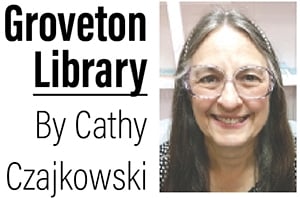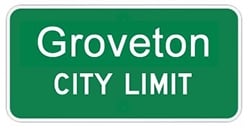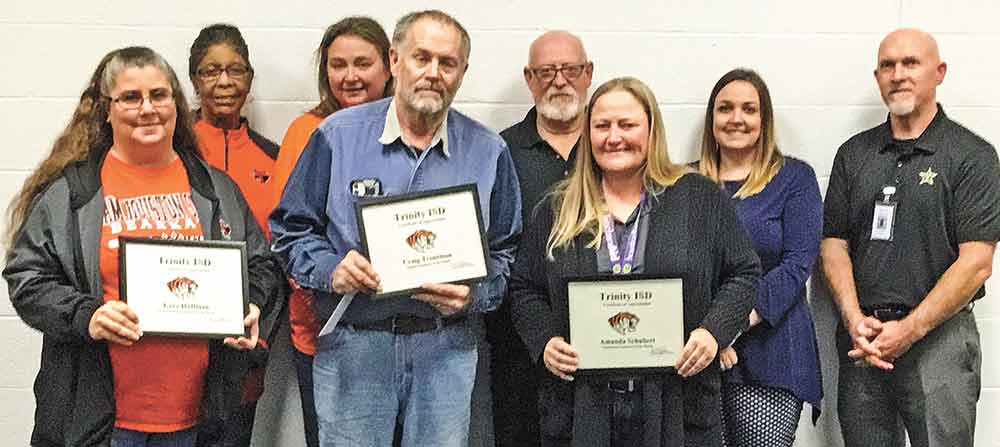 Write a comment
Write a comment
 Texas Workforce Solutions will be in the library on Thursday, Dec. 1, from 1-4 p.m. If you know someone who needs help with their resume or help with a work application, please come to the library. They have helped many people in our community.
Texas Workforce Solutions will be in the library on Thursday, Dec. 1, from 1-4 p.m. If you know someone who needs help with their resume or help with a work application, please come to the library. They have helped many people in our community.
•The library will have a booth at the Groveton Hometown Country Christmas on Saturday, Dec. 10, from 10 a.m. to 7 p.m. We will have used paperback books for sale. Jan Batchelor’s three children’s books will also be for sale and would make great gifts for your special child. Our raffle for you to take chances and our penny donation jars will be available.
•Make your plans to come by the library on Thursday, Dec. 22, between 1 and 6 p.m. for our Library Christmas Open House. We will have the drawing for our raffle at 5 p.m. You do not have to be present to win.
•The library has received a donation of the machines and a few materials to make our own greeting cards to sell. If anyone is interested in making their own greeting cards please come by and see what we have to offer. The library also has homemade cards for sale as a fundraiser. Come check us out. All cards are $1.
•The library is having a fundraiser for a new library building. The tickets are $5 per ticket. There will be three chances to win. The first item is 114 volumes of Louis L’ Amour leatherbound books which are a$1,000 value. The second item is a volume of “Journey to Jubilee, Groveton, Texas, USA,” a $100 value. The third item is three books written and signed by Janet Batchelor, our local author and they are “Al & the Owligator,” “Princess, Fred Frog and the Thing on the Log,” and “Fraidy Fox” with a $50 value.
All ticket sales will go towards our New Library Building Fund. The drawing will be held on Dec. 22 at the Library Christmas Open House. If you would like to purchase tickets, please call the library at (936) 642-2483 or come by the library between the hours of 1-6 p.m. Your librarian will also be at upcoming events to promote our library. Please stop and visit if you see me in your area. You do not have to be present to
•Donation jars are at One Stop Grocery and Pizza, McClain’s Hardware and Susie Q’s. Please support these businesses because they support our town and your library. The donation jars and the card class proceeds were $72.55. This brings our New Library Building Fund total to $3,047.83. Thank you to everyone who is bringing pennies and dropping change into jars. It will take everyone saving pennies to reach our goal of 1 million pennies. That goal will happen, and I believe it will be soon. Your librarian is reaching out to all organizations in our area asking for their help.
More information will be coming soon about this fundraiser.
•The library offers copy services and fax services and Notary Public services.
The library offers ESL (English as a Second Language) class on Monday and Friday from 2-3 p.m. If anyone is interested, please call or come by the library. This is a free service to the community and is taught by a retired teacher who donates her time.
If you are aware of any person that is homebound and cannot get to the library but would like to have books to read, please call the library. We will work on a time for delivery and pickup of books if someone shows interest. This is your library. Please let me know how I can be of service to you.
Our hours of operation are Monday through Friday from 1 to 6 p.m.
Story time is at 5 p.m. Tuesdays and Thursdays. ESL class is at 2 p.m. Friday
The library phone number is (936) 642-2483, and the location is in the rock building just east of the courthouse.
Cathy Czajkowski is director of the Groveton Public Library.
 TCNS staff
TCNS staff


 By Mollie La Salle
By Mollie La Salle
